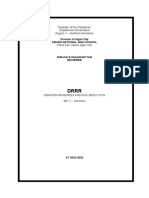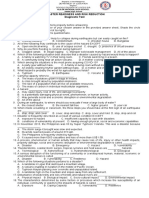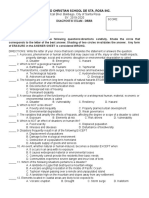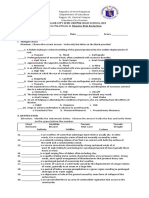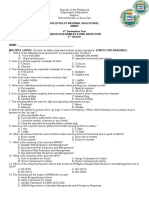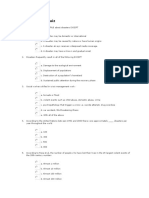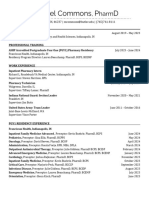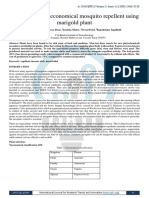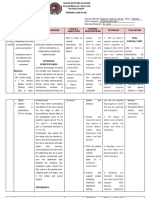Professional Documents
Culture Documents
Prefinal DRRM
Prefinal DRRM
Uploaded by
Anonymous elE1cg6100%(1)100% found this document useful (1 vote)
396 views3 pagesThis document appears to be a pre-final exam for a disaster risk reduction and management (DRRM) course given at Cagay National High School in Cebu Province, Philippines. The exam contains 36 multiple choice questions testing students' knowledge of key concepts in disaster management, different types of hazards (e.g. earthquakes, volcanoes, tsunamis), and appropriate responses during hazard events. Question topics include the roles of first responders, theories of disaster management, factors determining humanitarian aid, and characteristics of hazards such as earthquakes, volcanic eruptions, flooding and landslides.
Original Description:
tttt
Original Title
prefinalDRRM
Copyright
© © All Rights Reserved
Available Formats
DOCX, PDF, TXT or read online from Scribd
Share this document
Did you find this document useful?
Is this content inappropriate?
Report this DocumentThis document appears to be a pre-final exam for a disaster risk reduction and management (DRRM) course given at Cagay National High School in Cebu Province, Philippines. The exam contains 36 multiple choice questions testing students' knowledge of key concepts in disaster management, different types of hazards (e.g. earthquakes, volcanoes, tsunamis), and appropriate responses during hazard events. Question topics include the roles of first responders, theories of disaster management, factors determining humanitarian aid, and characteristics of hazards such as earthquakes, volcanic eruptions, flooding and landslides.
Copyright:
© All Rights Reserved
Available Formats
Download as DOCX, PDF, TXT or read online from Scribd
Download as docx, pdf, or txt
100%(1)100% found this document useful (1 vote)
396 views3 pagesPrefinal DRRM
Prefinal DRRM
Uploaded by
Anonymous elE1cg6This document appears to be a pre-final exam for a disaster risk reduction and management (DRRM) course given at Cagay National High School in Cebu Province, Philippines. The exam contains 36 multiple choice questions testing students' knowledge of key concepts in disaster management, different types of hazards (e.g. earthquakes, volcanoes, tsunamis), and appropriate responses during hazard events. Question topics include the roles of first responders, theories of disaster management, factors determining humanitarian aid, and characteristics of hazards such as earthquakes, volcanic eruptions, flooding and landslides.
Copyright:
© All Rights Reserved
Available Formats
Download as DOCX, PDF, TXT or read online from Scribd
Download as docx, pdf, or txt
You are on page 1of 3
Department of Education
Region VII, Central Visayas
Cebu Province
CAGAY NATIONAL HIGH SCHOOL
Cagay, Barili, Cebu
PRE – FINAL EXAM IN DRRM
Name: Date: Score:
I. Multiple Choice. Encircle the correct answer.
1. All of the following are TRUE about disasters EXCEPT
a. A disaster may be domestic or international
b. A disaster may be caused by nature or have human origins
c. A disaster always receives widespread media coverage.
d. A disaster may have a known and gradual onset
2. Disasters frequently result in all of the following EXCEPT
a. Damage to the ecological environment c. Destruction of a population"s homeland
b. Displacement of populations d. Sustained public attention during the recovery phase
3. Social workers skilled in crisis management work:
a. tornado or flood
b. violent events such as child abuse, domestic abuse, crime
c. psychopathology that triggers a crisis i.e. suicide attempt, drug overdose
d. car accident, life-threatening illness
e. With all of the above
4. According to the United Nations between 1992 and 2000 there were approximately ____ disasters per
year throughout the world
a. 100 b. 300 c. 500 d. 800
5. According to Reza et al, the number of people who have lost their lives in the 25 largest violent events
of the 20th century number:
a. Almost 1 million b. Almost 10 million c. Almost 100 million d. Almost 200 million
6. Responsibility for securing the scene, preserving life and treating the wounded is the responsibility of:
a. First responders b. Mental health professionals
c. Social workers who specialize in crisis management d. All citizens
7. There are nine tasks in the of disaster management. All of the following are tasks of this model
EXCEPT:
a. Assess secondary social problems such as health epidemics, displaced persons
b. Counsel those who have suffered trauma and bereavement
c. Control rumors, provide accurate information
d. Provide security; prevent looting, protect person and property
8. Which one of the following theories of disaster management informs organizational readiness and
response in a disaster?
a. Hobfoll"s theory of Conservation of Resources b. The problem-solving"task model
c. Structure-functional theory d. Theory of traumatogenic forces
9. The decision to offer humanitarian aid is determined by:
a. Theories of social justice b. Deontological reasoning
c. Teleological reasoning d. Socio-political factors
e. All of the above.
10. Conditions for the delivery of concrete goods and services at a disaster site include all of the following
EXCEPT:
a. Extreme climates; hot cold, wet, etc.
b. Crowded and cramped conditions for living and working
c. Lack of privacy, threat to safety
d. A clear demarcation of being on or off duty.
11. The play all of the following roles in covering a disaster EXCEPT:
a. Shapes public sympathy by the amount and type of coverage
b. Problem-solves obstacles encountered in the delivery of relief
c. Identifies heroes
d. Attempts to assign blame related to the cause of the disaster or for failures in response
12. __________ is a dangerous phenomenon, substance, human activity or condition that may cause
loss of life, injury or other health impacts, property damage, loss of livelihood & services, social &
economic disruption or environmental damage
a. disaster b. hazard c. risk d. exposure
13. __________ is the combination of all strengths and resources available within the community, society or
organization that can reduce the level of risk or effects of a disaster.
a. Vulnerability b. Risk c. Exposure d. Capacity
14. __________ is a dangerous phenomenon, substance, human activity or condition that may cause
loss of life, injury or other health impacts, property damage, loss of livelihood & services, social &
economic disruption or environmental damage
a. Hazard b. Risk c. Vulnerability d. Disaster
15. Which of the following is a combination of Probability of an event to happen and its negative
consequences
a. Vulnerability b. Risk c. Exposure d. Capacity
16. Which of the following are the characteristics and circumstances of a community, system or
asset that make it susceptible to the damaging effects of a hazard.
a. Vulnerability b. Risk c. Exposure d. Disaster
17. Which of the following describes the inability of the people, organization and society to withstand the
adverse impact to hazards due to characteristics inherent to social interactions, institutions and
system of cultural values?
a. physical b. environmental c. social d. economic
18. Natural resources depletion and degradation is an example of which vulnerability?
a. physical b. environmental c. social d. economic
19. __________ is the potential disaster losses, in lives, health status, livelihoods, assets and services,
which could occur to a particular community or a society over some specified future time period
a. Disaster Risk b. Disaster c. Hazard d. Disaster Management
20. Which of the following is an example of hydrometeoroligical hazard?
a. El Niño b. earthquake c. water pollution d. volcanic eruption
21. Tsunami is an example of which hazard?
a. geologic b. hydrometeorological c. technological d. biological
22. Which of the following is not a common long term impact of hazards
a. psychological b. economic c. environmental d. technological
23. Which can't be prevented but can be anticipated generally?
a. Human-made hazards b. Disasters
c. Socio-natural Hazards d. Natural Hazards
24. Earthquake may be caused by which of the following?
a. Tectonic b. volcanic eruption c. tsunami d. landslide
25. ________ is a disruptive up-down and sideways movement or motion experienced during an
earthquake.
a. Ground shaking b. ground rupture c. liquefaction d. faulting
26. __________ is a displacement on the ground due to movement of fault
a. Ground shaking b. ground rupture c. liquefaction d. grounding
27. ______________ are failures in steep or hilly slopes triggered by an earthquake
a. ground shaking b. earthquake induced landslide c. liquefaction d. erosion
28. It is a process that transforms the behavior of a body of sediments from that of a solid to that of a
liquid when subjected to extremely intense shaking.
a. ground shaking b. earthquake induced landslide c. liquefaction d. erosion
29. This is a series of giant sea waves commonly generated by under-the-sea earthquakes and whose
heights could be greater than 5 meters
a. tsunami b. storm surge c. tide d. thunderstorm
30. During an earthquake, which among the following is / are the safe thing/s to do?
a. Do the “duck, cover and hold” c. Stay calm
b. Secure all your belongings d. Run immediately to a safe area
31. Which of the following might be probably the cause of an earthquake?
a. An asteroid reaching the ground c. volcanic activity
b. Tectonic activity d. tsunami
32. Which among the following would be the last to do in an earthquake incident?
a. do the “duck, cover and hold” c. secure all your family members are safe
b. retrofit your buildings/ house from earthquake d. remove all possible falling objects
33. Which of the following brings an immediate hazard / damage to mankind?
a. lava b. tephra c. lahar d. magma
34. These are showers of airborne fine- to coarse-grained volcanic particles that fallout from the plumes of
a volcanic eruption
a. tephra fall b. lahar c. pyroclastic flows d. ballistic projectiles
35. These are turbulent mass of ejected volcanic materials (ash and rocks),mixed with hot gases that flow
downslope at very high speeds
a. tephra fall b. lahar c. pyroclastic flows d. ballistic projectiles
36. These are Volcanic materials directly ejected from the volcano’s vent with force and trajectory
a. tephra fall b. lahar c. pyroclastic flows d. ballistic projectiles
37. Which of the following could be possible means to mitigate the impact of lava flow?
a. cooling down lava by water c. bomb explosion
b. evacuation d. stay in your houses
38. Which of the following is the best way to mitigate from all volcanic hazards?
a. cooling down lava by water c. bomb explosion
b. evacuation d. stay in your houses
39. Which among the following is the most dangerous area /place from lava flows?
a. low-lying area b. mountains c. away from 5 km danger zone d. evacuation area
40. Which of the following is/ are part of the tetrahedron of fire?
a. oxygen b. fuel c. heat d. water
41. ________________ is an active principle of burning, characterized by the heat and light of combustion
a. Tetrahedron of fire b. fuel c. fire d. extinguishment theory
42. It is a stage of fire wherein the fire starts and there is plenty of oxygen, little heat and smoke
a. Ignition stage b. growth stage c. flash over d. decay
43. It is a fire extinguishment theory that is done by oxygen dilution
a. cooling b. smothering c. fuel removal d. inhibition
44. Why do we have to target the base of the fire during fire extinguishing?
a. to cool down the temperature
b. to stop the fuel from burning
c. to remove oxygen from the tetrahedron of fire
d. all of the above
45. Which of the following should be done when the source of fire is electrical appliances / electricity?
a. extinguish it with water
b. use fire extinguisher
c. switch off the main fuse
d. cover the appliance with wet cloth
46. When tying a triangular bandage, you must both ends of the bandage in a ___________ knot.
a. Square c. Circle
b. Rectangle d. Triangle
47. Which of the following is NOT correct when applying a triangular bandage on the head?
a. Fold the base twice, the width of the folds should be around 2-3inches
b. The folded base should be placed at the level of the eyebrows
c. The folded base should be placed at the level of the eyes
d. Pull the apex down to apply pressure to the compressed injury
48. Which of the following is correct when applying a sling?
a. Place the apex under the armpit of the uninjured arm
b. Place any of the tail under the armpit of the injured arm
c. Place the apex over the shoulder of the injured arm
d. Place the apex under the armpit of the injured arm
49. A sling should only be applied on what type of injury/ies? (select all that apply, right minus wrong)
a. Dislocated elbow c. Burnt forearm
b. Fractured forearm d. Open wound on the wrist
50. All of the following are examples of a closed wound, except:
a. Sprain
b. Strain
c. Contusion
d. None of the above
Prepared by:
RYAN G. VILLAFLORES
Subject Teacher
Checked by:
SUSAN F. ROXAS
School Head
Parents’ Signature Over Printed Name/ Date
You might also like
- DRRR Q1 Summative Test 1Document3 pagesDRRR Q1 Summative Test 1MA. HAZEL TEOLOGO100% (2)
- Pre Test - Disaster Readiness and Risk ReductionDocument2 pagesPre Test - Disaster Readiness and Risk ReductionMaria Elaine Ramos67% (3)
- DRRR 1st Quarter ExamDocument5 pagesDRRR 1st Quarter ExamEMILY MAG-ALASIN100% (3)
- 3rd Quarter Exam DRRRDocument2 pages3rd Quarter Exam DRRRrichard babas100% (10)
- Midterm Exam DRRR SY 2018 2019Document6 pagesMidterm Exam DRRR SY 2018 2019Janix MagbanuaNo ratings yet
- Midterm Exam DRRR SY 2018-2019Document6 pagesMidterm Exam DRRR SY 2018-2019Jhen Barnard85% (34)
- 1st Long Quiz in DRRR 2nd SemDocument2 pages1st Long Quiz in DRRR 2nd SemChristine Apolo100% (2)
- DRRR Mid Term Exam 2018Document4 pagesDRRR Mid Term Exam 2018Ryan Negad100% (27)
- DRRR 2nd ExamDocument3 pagesDRRR 2nd ExamMichelle Kambwili100% (3)
- Disaster Risk Reduction Management 1 Senior High SchoolDocument42 pagesDisaster Risk Reduction Management 1 Senior High SchoolJerome BigaelNo ratings yet
- The SuDS Manual C697Document9 pagesThe SuDS Manual C697GANGA RSNo ratings yet
- DRRR ExamDocument4 pagesDRRR ExamShaira Bartido100% (1)
- Quarter 1 Exam - DRRRDocument4 pagesQuarter 1 Exam - DRRRKevin Arnaiz100% (1)
- Long Test 3RD Grading DRRRDocument2 pagesLong Test 3RD Grading DRRRmaria pamela m.surbanNo ratings yet
- Test Questionnaire Disaster Readiness and Reduction 3rd QuarterDocument4 pagesTest Questionnaire Disaster Readiness and Reduction 3rd QuarterzhaninakayeNo ratings yet
- Disaster Risk Reducation - Reviewer EXAM PDFDocument2 pagesDisaster Risk Reducation - Reviewer EXAM PDFElectona Kai SairNo ratings yet
- DRRRDocument5 pagesDRRRrheza oropa100% (1)
- NAME: - COURSE/SECTION: - SCORE: Long Quiz in DRRRDocument3 pagesNAME: - COURSE/SECTION: - SCORE: Long Quiz in DRRRRenz GaraisNo ratings yet
- NAT DRRM Questionnaire Set1Document13 pagesNAT DRRM Questionnaire Set1Shirley RaborNo ratings yet
- Summative Test in DRRRDocument3 pagesSummative Test in DRRRGericNo ratings yet
- DRRRM Midterm Exam 2nd SemDocument3 pagesDRRRM Midterm Exam 2nd SemRenier Dela Vega FloresNo ratings yet
- DRRR Diagnostic TestDocument3 pagesDRRR Diagnostic TestJuliane Rebecca Pitlongay100% (1)
- Summative Test in DRR1Document5 pagesSummative Test in DRR1jing100% (1)
- DRRR ReviewerDocument8 pagesDRRR ReviewerCatherine ManaloNo ratings yet
- DRRR Final Exam 2020Document3 pagesDRRR Final Exam 2020Argie Joy Marie AmpolNo ratings yet
- 3rd DRRR EXAMDocument2 pages3rd DRRR EXAMMary Jane Tamondong Baniqued100% (2)
- DRR11Document8 pagesDRR11Llermi Liborio100% (1)
- 3rd Final ExamDocument9 pages3rd Final ExamMira Verano100% (1)
- DRRR Chapter Test On DisasterDocument2 pagesDRRR Chapter Test On DisasterTeacher MoNo ratings yet
- Periodical DRRR FinalDocument5 pagesPeriodical DRRR FinalMiss RonaNo ratings yet
- Blessed Christian School de Sta. Rosa Inc.: Rizal Blvd. Balibago, City of Santa Rosa SY: 2019-2020Document4 pagesBlessed Christian School de Sta. Rosa Inc.: Rizal Blvd. Balibago, City of Santa Rosa SY: 2019-2020Angelyn LingatongNo ratings yet
- DRRR - Q2 - Summative 3Document4 pagesDRRR - Q2 - Summative 3Billy Jasper DomingoNo ratings yet
- 1st Quarter ExamDocument3 pages1st Quarter Examrheza oropaNo ratings yet
- Biñan Integrated National High School Senior High School Pre-Final Exam Disaster Readiness and Risk ReductionDocument3 pagesBiñan Integrated National High School Senior High School Pre-Final Exam Disaster Readiness and Risk ReductionMiss Rona100% (3)
- DRR Semi-Final ExamDocument6 pagesDRR Semi-Final ExamVerna M. Reyes100% (4)
- Exam - DRRRDocument3 pagesExam - DRRRmycah hagadNo ratings yet
- Test Questionnaire - DRRRDocument3 pagesTest Questionnaire - DRRRAlbert Rosete100% (1)
- Midterm Exam DRRRDocument2 pagesMidterm Exam DRRRManuel Paulo AcogidoNo ratings yet
- Quiz DRRRDocument3 pagesQuiz DRRRGlenn Cacho Garce100% (6)
- Diagnostic ExamDocument6 pagesDiagnostic ExamLG Niegas100% (1)
- DRRR Handout Volcanic HazardDocument4 pagesDRRR Handout Volcanic HazardAnonymous fKViHeaw0% (1)
- DRRR 4TH Quarter Exam.Document4 pagesDRRR 4TH Quarter Exam.Faxman Cavan SingcoNo ratings yet
- DRRR Final ExamDocument3 pagesDRRR Final ExamErnie Maximo100% (3)
- DRR1Document2 pagesDRR1MASH100% (1)
- DRRR Exam.Document7 pagesDRRR Exam.Claudette M.Magararu100% (1)
- Final Examination in Cs110 - DRRR - Answer KeyDocument10 pagesFinal Examination in Cs110 - DRRR - Answer KeyPrincess Ira SantillanNo ratings yet
- Name: - Score: - Year and Section: - DateDocument2 pagesName: - Score: - Year and Section: - DateEmerson Mercado GalanoNo ratings yet
- 3 Exposure and VulnerabilityDocument22 pages3 Exposure and Vulnerabilityjonel tuazon83% (6)
- Summative Test DRRR (4th ST-2nd Q)Document2 pagesSummative Test DRRR (4th ST-2nd Q)Kennedy Fieldad Vagay100% (2)
- Disaster Readiness and Risk Reduction Final ExamDocument7 pagesDisaster Readiness and Risk Reduction Final ExamCP Yttrep100% (1)
- First Summative Test DRRR 4th Quarter New NormalDocument2 pagesFirst Summative Test DRRR 4th Quarter New NormalRenzelle Guilaran GerocheNo ratings yet
- Disaster Readiness & Risk Reduction (4 Quarter Reviewer) : Southwest MonsoonDocument4 pagesDisaster Readiness & Risk Reduction (4 Quarter Reviewer) : Southwest MonsoonFeiweibei SongNo ratings yet
- DRRM QuizDocument1 pageDRRM QuizJay-Ar Mario67% (9)
- DRRR Q2 Exam 20 ItemsDocument2 pagesDRRR Q2 Exam 20 ItemsJeffrey OralizaNo ratings yet
- Table of Specification Disaster Readiness and Risk Reduction 2nd Semester FINAL EXAMDocument2 pagesTable of Specification Disaster Readiness and Risk Reduction 2nd Semester FINAL EXAMRICHARD CORTEZNo ratings yet
- "Disaster Readiness and Risk Reduction": Test 2 True or FalseDocument2 pages"Disaster Readiness and Risk Reduction": Test 2 True or FalseMiki AntonNo ratings yet
- Hydro Meteorological Hazards QuizDocument8 pagesHydro Meteorological Hazards QuizMarfori Garcia67% (3)
- First Quarter Exam DRRR (2019-2020)Document5 pagesFirst Quarter Exam DRRR (2019-2020)Jhoy100% (3)
- 3rdquarter DRRRDocument5 pages3rdquarter DRRRCarlz BrianNo ratings yet
- Multiple Choice QuizDocument5 pagesMultiple Choice Quizsusan aralarNo ratings yet
- Midterm Assessment For 3RD Quarter2Document4 pagesMidterm Assessment For 3RD Quarter2Erumi ShidouNo ratings yet
- Midterm Pe 12Document3 pagesMidterm Pe 12Anonymous elE1cg6No ratings yet
- 3RDSUM8Document2 pages3RDSUM8Anonymous elE1cg6No ratings yet
- Bread and Pastry ProductionDocument13 pagesBread and Pastry ProductionAnonymous elE1cg6No ratings yet
- Deped Cebu Province Ipho BLDG., Sudlon, Lahug, Cebu City: K To 12 ProgramDocument12 pagesDeped Cebu Province Ipho BLDG., Sudlon, Lahug, Cebu City: K To 12 ProgramAnonymous elE1cg6No ratings yet
- Uugnay Sa Talento, Kakayahan o Profession. (20 Words Lahat)Document1 pageUugnay Sa Talento, Kakayahan o Profession. (20 Words Lahat)Anonymous elE1cg6No ratings yet
- Uugnay Sa Talento, Kakayahan o Profession. (20 Words Lahat)Document1 pageUugnay Sa Talento, Kakayahan o Profession. (20 Words Lahat)Anonymous elE1cg6No ratings yet
- Makan AnDocument2 pagesMakan AnYusuf SwanNo ratings yet
- Filed Motion Court DocumentDocument13 pagesFiled Motion Court DocumentWXMINo ratings yet
- Benton Judgment of Line Orientation PDFDocument16 pagesBenton Judgment of Line Orientation PDFIrina DespaNo ratings yet
- Urn Uvci 01 Ro 230dmyqx5erjr6ygrqn719kv6wop8l#dDocument2 pagesUrn Uvci 01 Ro 230dmyqx5erjr6ygrqn719kv6wop8l#dRuxandra VasileNo ratings yet
- Play Therapy To Reduce Anxiety in Children: Wahyu - Endang.setyowati-2020@fkp - Unair.ac - IdDocument24 pagesPlay Therapy To Reduce Anxiety in Children: Wahyu - Endang.setyowati-2020@fkp - Unair.ac - IdbbpcheeseNo ratings yet
- CV 2024Document5 pagesCV 2024api-714782423No ratings yet
- Tuc Health Safety Organising Guide For Reps 2016 PDFDocument36 pagesTuc Health Safety Organising Guide For Reps 2016 PDFAnonymous iI88LtNo ratings yet
- Kermena Ishak Medical InequityDocument10 pagesKermena Ishak Medical Inequityapi-726009137No ratings yet
- Trans - Mls 101 - Chapter 3Document3 pagesTrans - Mls 101 - Chapter 3Camille De CastroNo ratings yet
- Marigold PlantDocument8 pagesMarigold PlantJ FarsaNo ratings yet
- TugasskhususDocument854 pagesTugasskhususZymethNo ratings yet
- Hygiene and Sanitation AssignmentsDocument2 pagesHygiene and Sanitation AssignmentsAmaresh Jha100% (1)
- Huang Et Al 2005 PDFDocument8 pagesHuang Et Al 2005 PDFYoga Bririan JatiNo ratings yet
- Book Review Clinical PharmacologyDocument3 pagesBook Review Clinical PharmacologyreyviNo ratings yet
- Ethyl Alcohol in Vitreous HumorDocument11 pagesEthyl Alcohol in Vitreous HumorRosaniza KamarudinNo ratings yet
- Mier NCPDocument3 pagesMier NCPMacy MarquezNo ratings yet
- WHO PHL COVID 19 Situation Report 114Document9 pagesWHO PHL COVID 19 Situation Report 114jessica sugaboNo ratings yet
- Rheumatoid Arthritis AmavataDocument29 pagesRheumatoid Arthritis AmavataDr Veenu YadavNo ratings yet
- Lesson 7.7Document9 pagesLesson 7.7Hà VũNo ratings yet
- Endogenous Factors Associated To Anatomopathological Lesions of CuDocument7 pagesEndogenous Factors Associated To Anatomopathological Lesions of Cuderrick ngueguimNo ratings yet
- How To Secure Various Documents For SeafarersDocument68 pagesHow To Secure Various Documents For SeafarersFrednixen Bustamante GapoyNo ratings yet
- Practice Advisory On Controversial Topics in Pediatric Regional AnesthesiaDocument7 pagesPractice Advisory On Controversial Topics in Pediatric Regional AnesthesiaDorica GiurcaNo ratings yet
- Office SafetyDocument40 pagesOffice SafetyAlaa AbdallahNo ratings yet
- Advantages of Ester Over Mineral OilDocument8 pagesAdvantages of Ester Over Mineral OilMenoddin shaikhNo ratings yet
- Cardiovascular Surgery in The Elderly: Salim and LDocument19 pagesCardiovascular Surgery in The Elderly: Salim and LThanh BinhNo ratings yet
- Presentation 1 MeditationDocument8 pagesPresentation 1 Meditationapi-533353748No ratings yet
- Nasal Reconstruction 1Document11 pagesNasal Reconstruction 1geoffrowley3No ratings yet
- Acute AppendicitisDocument1 pageAcute AppendicitisAllen AykayNo ratings yet
- The Role of The Nurse in Palliative Care Settings in A Global ContextDocument6 pagesThe Role of The Nurse in Palliative Care Settings in A Global Context_astyNo ratings yet


















